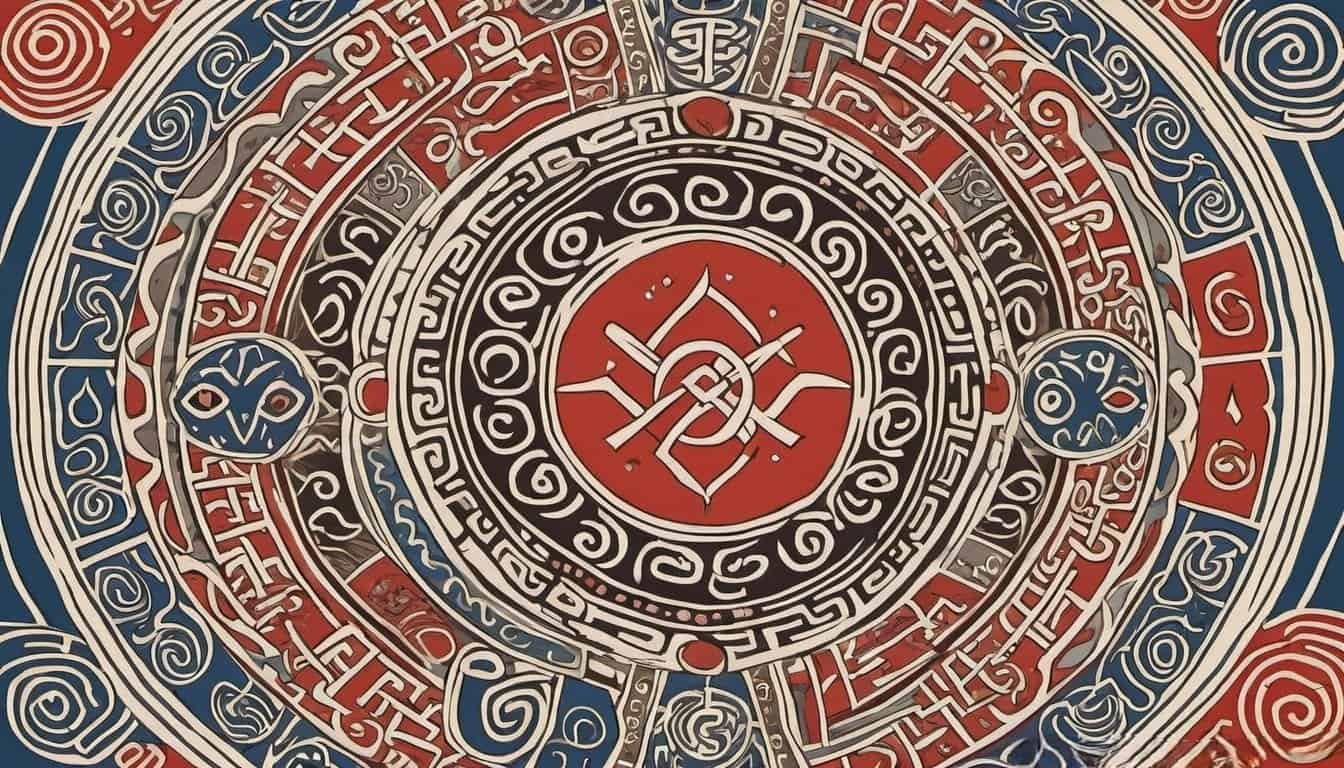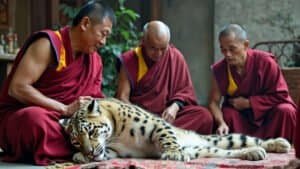Introduction
Snow leopards hold a significant place in the traditional folklore of Mongolia, where they are revered as powerful symbols of majesty and spirituality. This article delves into the various ways in which these elusive big cats have influenced Mongolian myths, legends, and cultural practices
From their portrayal in ancient stories to their symbolic representation in art, literature, and shamanic rituals, snow leopards have left an indelible mark on Mongolia’s cultural heritage
We will explore the deep-rooted beliefs, spiritual meanings, and the enduring legacy of snow leopards in Mongolian folklore
Snow Leopards in Mongolian Myths and Legends
Snow leopards, known as irbis in Mongolia, are deeply embedded in the nation’s folklore and are often portrayed as mystical creatures with immense power. Their elusive nature and majestic presence in the high altitudes of the Mongolian mountains have inspired numerous legends and stories passed down through generations
These tales reflect the profound respect Mongolians have for the snow leopard, viewing it not only as a powerful predator but also as a spiritual being that bridges the natural and supernatural worlds
The reverence for snow leopards in Mongolian folklore underscores their role as protectors of the land and as symbols of resilience and mystery
Common Snow Leopard Myths in Mongolia
Mongolian folklore is rich with stories that feature the snow leopard as a central figure. One of the most prevalent myths tells of the snow leopard as a guardian spirit of the mountains, believed to protect both the land and its people from evil forces
In these tales, the snow leopard is often depicted as a wise and noble creature, embodying qualities of strength, courage, and stealth. It is said that the snow leopard has the ability to vanish into the mist, becoming invisible to those who wish to harm it, which only adds to its mystical allure
Another common legend speaks of the snow leopard as a shape-shifter, capable of transforming into a human to interact with the people of the mountains
This belief in the snow leopard’s supernatural abilities has led to its association with various deities and spirits within Mongolian shamanism. Some stories even suggest that the snow leopard is a manifestation of a revered ancestor, returning in animal form to guide and protect the descendants
The snow leopard’s role as a protector is further emphasized in folktales where it intervenes to save humans from danger. For instance, in some stories, a snow leopard appears just in time to fend off other predators or to guide lost travelers back to safety
These narratives have contributed to the perception of the snow leopard as a benevolent and almost sacred creature, deserving of respect and reverence
Spiritual Significance in Mongolian Shamanism
In Mongolian shamanism, snow leopards are revered as spiritual beings with the power to traverse the realms of the physical and the spiritual. Shamans, who serve as mediators between the human and spirit worlds, often invoke the snow leopard’s spirit during rituals and ceremonies
The snow leopard is believed to possess qualities that are essential for a shaman’s work, such as keen perception, agility, and the ability to move unseen between different realms
The snow leopard’s association with shamanic practices can be seen in the traditional costumes and symbols used by Mongolian shamans. Some shamans wear cloaks adorned with snow leopard fur or patterns that mimic the leopard’s distinctive spots, symbolizing their connection to the animal’s spirit
These garments are not only a tribute to the snow leopard but also serve as a protective charm, believed to endow the shaman with the leopard’s power and wisdom
Moreover, the snow leopard is often called upon during rituals to protect the community from evil spirits or to ensure successful hunts. The shaman might enter a trance-like state, channeling the spirit of the snow leopard to gain insight or to draw upon its strength
This deep spiritual connection has made the snow leopard an enduring symbol in Mongolian culture, representing the link between the natural world and the mystical forces that govern it
Historical Origins of Snow Leopard Legends
The origins of snow leopard legends in Mongolia can be traced back to ancient times when nomadic tribes roamed the vast steppes and mountains. The harsh and rugged terrain of Mongolia, coupled with the snow leopard’s rare sightings, contributed to the animal’s legendary status
Early Mongolian tribes likely observed the snow leopard from a distance, captivated by its grace and power, which sparked the creation of myths that celebrated its prowess
These legends have been passed down orally through generations, evolving over time but always retaining the core elements of the snow leopard’s mystique. The nomadic lifestyle of Mongolians, which is deeply connected to nature and the cycles of life, has also played a significant role in shaping these stories
The snow leopard, as a symbol of the wild and untamed wilderness, came to embody the spirit of the Mongolian people, who have long revered the natural world as both a source of sustenance and spiritual guidance
Throughout history, the snow leopard has also appeared in Mongolian epic poetry and songs, where it is often depicted as a noble creature that commands respect. These literary traditions have helped to preserve and propagate the snow leopard’s legendary status, ensuring that its place in Mongolian folklore remains strong even as the country modernizes
Snow Leopards in Mongolian Art, Literature, and Culture
The snow leopard’s influence extends beyond mythology into various facets of Mongolian art, literature, and culture
As a symbol of power, resilience, and spirituality, the snow leopard has been depicted in traditional Mongolian art forms, celebrated in literary works, and deeply woven into cultural practices
These representations not only reflect the animal’s physical beauty and enigmatic nature but also reinforce its symbolic importance in Mongolian identity and heritage
Representation in Traditional Art and Crafts
Traditional Mongolian art often draws inspiration from the natural world, with the snow leopard serving as a prominent subject
In ancient rock carvings and petroglyphs found in Mongolia’s remote mountain regions, images of snow leopards are etched alongside other revered animals, indicating their significance in the region’s early cultures
These depictions, some of which date back thousands of years, highlight the deep connection Mongolians have with the snow leopard, viewing it as an integral part of their environment and spiritual world
In more recent centuries, snow leopards have been represented in various forms of Mongolian crafts. For example, traditional Mongolian tapestries and textiles often feature intricate designs that include snow leopards, sometimes stylized in ways that emphasize their graceful movement or predatory nature
These artistic representations are not merely decorative; they serve as a way to honor the snow leopard’s role in Mongolian culture, symbolizing protection, strength, and the harsh beauty of the Mongolian landscape
The influence of snow leopards can also be seen in the design of traditional Mongolian clothing. Patterns inspired by the snow leopard’s distinctive fur are incorporated into the garments worn by nomadic herders, particularly in regions where snow leopards are native
These patterns are believed to confer the animal’s qualities onto the wearer, such as resilience and the ability to navigate difficult terrain, reflecting the deep cultural ties between Mongolians and the snow leopard
The Role in Mongolian Literature
Snow leopards have also made their mark in Mongolian literature, where they are often depicted as powerful and enigmatic creatures. Mongolian epic poetry, which has a long tradition in the country, frequently features snow leopards as symbols of the wild and untamed forces of nature
In these epics, the snow leopard is portrayed as both a formidable adversary and a revered guardian, embodying the dual nature of the wilderness as both a source of danger and a provider of protection
One of the most famous Mongolian literary works that features the snow leopard is the epic of Geser Khan, a legendary warrior-king. In this epic, the snow leopard is depicted as a companion and protector of Geser Khan, symbolizing the hero’s strength, courage, and deep connection to the natural world
This portrayal underscores the snow leopard’s status as a creature of great power and spiritual significance, capable of guiding and protecting those who respect its domain
In addition to epic poetry, snow leopards appear in Mongolian folktales and stories passed down through generations. These tales often highlight the animal’s intelligence, agility, and independence, traits that are highly valued in Mongolian culture
The snow leopard is sometimes depicted as a trickster figure, outwitting other animals or humans, which adds a layer of complexity to its role in Mongolian literature. This duality—of the snow leopard as both a noble and cunning creature—reflects the multifaceted nature of Mongolian views on the natural world
Symbolism in Cultural Beliefs and Practices
The snow leopard’s symbolic power in Mongolian culture is evident in various traditional beliefs and practices. In many parts of Mongolia, the snow leopard is considered a spiritual guardian, and its presence is seen as a positive omen
This belief is particularly strong in regions where snow leopards are native, such as the Altai Mountains, where locals may leave offerings or perform rituals to honor the snow leopard and seek its protection
These rituals often involve shamans, who play a crucial role in maintaining the spiritual balance between humans and the natural world. During ceremonies, the snow leopard is invoked as a powerful spirit capable of warding off evil and ensuring the well-being of the community
The reverence for the snow leopard in these practices highlights its role as a bridge between the physical and spiritual realms, embodying qualities that are essential for the survival and prosperity of the Mongolian people
In addition to its spiritual significance, the snow leopard also symbolizes the harsh beauty and resilience of the Mongolian landscape. It is often used as a metaphor for the Mongolian people’s own ability to endure and thrive in one of the most challenging environments on Earth
This symbolic association is reflected in various aspects of Mongolian culture, from proverbs and sayings to the design of national symbols
Moreover, the snow leopard has become a symbol of conservation and environmental protection in modern Mongolia. As the country grapples with the challenges of development and climate change, the snow leopard serves as a reminder of the importance of preserving Mongolia’s natural heritage
Conservation efforts to protect the snow leopard are not just about saving a species; they are about preserving a symbol of Mongolia’s cultural and spiritual identity
The Symbolic Power of the Snow Leopard in Mongolia
The snow leopard’s symbolic power in Mongolia transcends its physical presence, permeating various aspects of Mongolian spirituality, cultural identity, and social values
As a creature of mystery and majesty, the snow leopard embodies qualities that are deeply respected in Mongolian society, such as strength, resilience, and spiritual insight. This symbolic power is reflected in how Mongolians perceive the snow leopard, not only as an animal but also as a potent emblem of their connection to the natural and spiritual worlds
Symbol of Power and Majesty
In Mongolian culture, the snow leopard is often seen as a symbol of power and majesty. This is partly due to its status as a top predator in the rugged mountain ranges where it resides, but it also stems from its elusive nature, which adds to its mystique
The snow leopard’s ability to survive in some of the harshest environments on Earth—where few other creatures can thrive—has made it a symbol of endurance and strength. These qualities are highly valued in Mongolian society, where the ability to endure and succeed against the odds is celebrated
The snow leopard’s majestic presence is often invoked in Mongolian rituals and ceremonies, particularly those that involve seeking strength or protection
For example, in traditional wrestling, which is a popular sport in Mongolia, wrestlers may invoke the spirit of the snow leopard to draw upon its strength and agility. The snow leopard’s grace and power are seen as traits that can inspire and empower individuals, particularly in challenging situations
In a broader sense, the snow leopard represents the majesty of the Mongolian landscape itself. The vast, untamed wilderness of Mongolia’s mountains and steppes is mirrored in the snow leopard’s presence, symbolizing the grandeur and raw beauty of the natural world
This association reinforces the snow leopard’s status as a national symbol, representing not just physical power but also the spiritual and cultural strength of Mongolia
Snow Leopard as a Spiritual Guardian
Beyond its physical attributes, the snow leopard is revered in Mongolia as a spiritual guardian. This belief is deeply rooted in Mongolian shamanism, where animals often serve as totems or spiritual guides
The snow leopard, with its keen senses and ability to navigate the treacherous mountain terrain, is seen as a protector of both the land and the people who live there. It is believed that the snow leopard watches over the mountains, ensuring that the balance between humans and nature is maintained
In many Mongolian communities, the snow leopard is considered a guardian spirit that can provide protection from evil forces. This belief is particularly strong in regions where snow leopards are still found in the wild, such as the Altai Mountains
Here, locals may perform rituals to honor the snow leopard, offering prayers or gifts to appease the spirit of the animal and seek its blessing. These rituals often involve shamans, who act as intermediaries between the human and spirit worlds, calling upon the snow leopard to protect the community
The role of the snow leopard as a spiritual guardian also extends to its presence in dreams and visions. In Mongolian shamanic traditions, encountering a snow leopard in a dream is seen as a powerful omen, often signaling a significant spiritual message or a call to action
Such dreams are taken seriously and may prompt individuals to seek guidance from a shaman or to undertake specific rituals to honor the snow leopard’s message
This spiritual connection has made the snow leopard a symbol of protection and guidance in Mongolian culture. Its role as a guardian is not limited to the physical world but extends to the spiritual realm, where it is believed to help maintain the balance between good and evil, ensuring the well-being of those who honor its presence
Impact on Mongolian Identity and Heritage
The snow leopard’s symbolic power has also had a profound impact on Mongolian national identity and heritage. As one of the most iconic animals native to Mongolia, the snow leopard is often used as a symbol of the country’s natural and cultural heritage
It represents not only the rugged beauty of Mongolia’s landscapes but also the resilience and strength of the Mongolian people, who have adapted to and thrived in a harsh environment over centuries
This connection between the snow leopard and Mongolian identity is reflected in various aspects of national symbolism. For example, the snow leopard is featured in logos and emblems associated with conservation efforts, highlighting the importance of protecting this majestic creature as part of preserving Mongolia’s natural heritage
Additionally, the snow leopard is often used in branding and tourism to promote Mongolia’s image as a land of unspoiled wilderness and rich cultural traditions
The snow leopard’s influence on Mongolian heritage is also evident in the way it is celebrated in festivals and cultural events. In some regions, festivals are held in honor of the snow leopard, where traditional dances, songs, and rituals are performed to pay tribute to the animal
These events serve as a way to reinforce the cultural significance of the snow leopard and to educate younger generations about its importance to Mongolian history and identity
Moreover, the snow leopard has become a symbol of conservation and environmental stewardship in Mongolia. As the country faces the challenges of modernization and climate change, the snow leopard represents the need to balance progress with the preservation of natural and cultural heritage
Efforts to protect the snow leopard are seen not just as a means of saving a species but as part of a broader commitment to maintaining the ecological and spiritual integrity of Mongolia
Conclusion
The snow leopard, or irbis, holds a profound place in Mongolian culture, influencing the nation’s folklore, art, literature, and spiritual practices. As both a symbol of power and a spiritual guardian, the snow leopard is revered for its majestic presence and its ability to navigate the harsh landscapes of Mongolia
Through myths and legends, it embodies the resilience and strength that are core to Mongolian identity. Its representation in art and literature further cements its role as a cultural icon, while its symbolic power continues to impact modern conservation efforts, ensuring that this enigmatic creature remains a vital part of Mongolia’s natural and spiritual heritage
The snow leopard’s legacy in Mongolia is not just about its physical survival but also about preserving the rich traditions and beliefs that have shaped Mongolian culture for centuries










